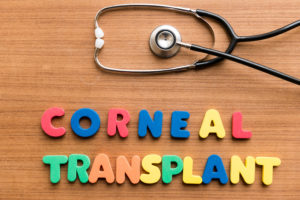
What is it?
The cornea is the clear membrane that covers the iris and pupil of the eye. If the cornea becomes clouded, stretched, or otherwise damaged, the patient’s vision is impaired or lost. A corneal transplant (keratoplasty) takes the cornea from a donor and transfers it to the patient. Doctors may transplant the entire cornea or only selected layers depending on the needs of the patient. A corneal transplant is often necessary in the event of corneal ulcers, corneal scarring, laceration, and several kinds of congenital syndromes. It is important for young children to receive eye exams early during development to identify and diagnose emerging vision problems.
How to Prepare
If the doctor determines that a corneal transplant is the appropriate option for the patient, he or she submits the patient’s information to a donor waiting list. The waiting process for a donor may last several days or weeks. Patients participate in eye exams and measurements during the days before to the procedure. Other eye issues (such as infections) are treated prior to surgery since these may cause complications.
What happens during the procedure?
The doctor administers local or general anesthesia depending on the health status and age of the patient. If a local anesthetic is used, the patient remains awake during surgery. The doctor may use eye drops or injections to numb the eye and relax facial muscles. The doctor then removes corneal tissue and replaces it with the healthy donor tissue. Stitches used to reestablish the corneal connection may remain in the eye for a year or longer to ensure attachment and recovery. A plastic shield is placed over the eye for post-surgical protection. Keratoplasty usually lasts one or two hours and can be performed on an outpatient basis.
Risks and Complications
* Eye infections
* Increased risk of cloudy eyes (cataracts)
* Increased risk of pressure within the eye (glaucoma)
* Rejection of the donor cornea
* Swelling of the cornea
* Bleeding
* Scarring
* Vision problems
* Leakage of fluid from transplant incision
Disclaimer:
All GlobeHealer Site content, including graphics, images, logos, and text, among other materials on the site are for educational purposes only. This content is not intended to be a substitute for professional medical advice, and you should always contact your physician or qualified health provider for information regarding your health. Information on this site regarding the overview, diagnosis, and treatment of any kind should be looked at, in addition to the advice and information of your health care professional. Do not disregard medical advice or delay seeking treatment or medical advice due to information found on the GlobeHealer site.
If there is even the possibility that you may have a medical emergency, seek treatment, call your doctor, or call your local emergency telephone number immediately. GlobeHealer does not endorse being the first line of communication in case of emergency and does not endorse any specific test, physician, facility, product, procedure, opinion, or other information that is or may be mentioned on this site or affiliated entities. Reliance of any and all information provided by GlobeHealer, its employees, affiliations, others appearing on the Site under the invitation of GlobeHealer, or visitors of the site is solely at your own risk and is not the responsibility of GlobeHealer.
